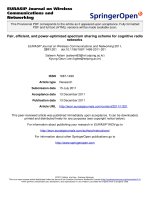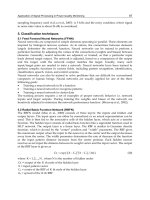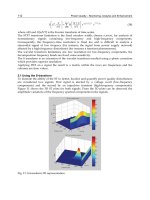PHYSICAL LAYER SECRECY ANALYSIS AND ENHANCEMENT FOR COGNITIVE RADIO NETWORKS
Bạn đang xem bản rút gọn của tài liệu. Xem và tải ngay bản đầy đủ của tài liệu tại đây (3.15 MB, 129 trang )
MINISTRY OF EDUCATION AND TRAINING
DUY TAN UNIVERSITY
TRƯƠNG TIẾN VŨ
PHYSICAL LAYER SECRECY ANALYSIS AND ENHANCEMENT
FOR COGNITIVE RADIO NETWORKS
DOCTOR OF PHILOSOPHY OF COMPUTER SCIENCE
Da Nang – 2020
MINISTRY OF EDUCATION AND TRAINING
DUY TAN UNIVERSITY
TRƯƠNG TIẾN VŨ
PHYSICAL LAYER SECRECY ANALYSIS AND ENHANCEMENT
FOR COGNITIVE RADIO NETWORKS
Major: Computer Science
Code: 9840101
Scientific Supervisors
Assoc. Prof. DƯƠNG QUANG TRUNG
PhD. HÀ ĐẮC BÌNH
Da Nang – 2020
Declaration of Original Work
I, Trương Tiến Vũ, hereby declare that the work entitled Physical Layer Secrecy Analysis and Enhancement for Cognitive Radio Networks is my original
work. I have not copied from any other postgraduates’ work or from any other
sources except where due references or acknowledgment is made explicitly in the
text, nor has any part been written for me by another person.
PhD candidate’s signature
Trương Tiến Vũ
I
Acknowledgements
This doctoral thesis have been implemented at Duy Tan University under
the supervision of Assoc. Prof. Dương Quang Trung and PhD. Hà Đắc Bình. I
would like to thank for their valuable guidance and support throughout my PhD
studies. Their advice, patience, kind supervision, and encouragement over my
study period have been vital for the completion of this thesis.
My warmest thanks go to my colleagues and the staff at the Graduate School
and Information Technology Faculty of Duy Tan University for their friendship
and help throughout my PhD studies.
Finally, I would like to deeply thank my family, and especially my wife, for
their love, support, and encouragement.
II
Table of Contents
Declaration of Original Work ............................................................................... i
Acknowledgements .............................................................................................. ii
Table of Contents ................................................................................................ iii
List of Abbreviations ......................................................................................... vii
List of Figures ..................................................................................................... ix
Introduction .........................................................................................................1
Research Motivations ........................................................................................1
Research Goal, Objectives, Scope, Methods .....................................................2
Research Missions, Related Works and Results................................................3
Results ................................................................................................................8
Chapter 1 ...........................................................................................................10
Background .......................................................................................................10
1.1 Introduction................................................................................................10
1.2 Wireless Communication Networks ..........................................................10
1.2.1 Fundamental of Wireless Channel ......................................................10
1.2.1.1 Multipath Propagation ...................................................................10
1.2.1.2 Fading ............................................................................................11
1.2.1.3 Channel Models .............................................................................13
1.2.2 Security Requirements and Future Challenges ...................................17
1.2.2.1 Security Requirements ..................................................................17
III
1.2.2.2 Future Challenges ..........................................................................19
1.3 Physical Layer Secrecy in Wireless Communication Networks ...............21
1.3.1 Introduction .........................................................................................21
1.3.2 Information Theory .............................................................................22
1.3.3 Physical Layer Secrecy over Fading Channel .....................................24
1.3.4 Physical Layer Security over Interference Channel ............................26
1.3.5 Physical Layer Secrecy in Cognitive Radio Networks .......................27
1.3.5.1 Cognitive Radio Networks ............................................................27
1.3.5.2 Physical Layer Secrecy in CRNs ..................................................28
1.4 Conclusions................................................................................................30
Chapter 2 ...........................................................................................................31
Physical Layer Secrecy Performance Analysis for Wireless Communications
with Dissimilar Fading Channels ....................................................................31
2.1 Introduction................................................................................................31
2.2 System and Channels Model .....................................................................32
2.2.1 The legal/illegal channels undergo Rayleigh/Rician fading ...............33
2.2.2 The legal/illegal channels undergo Rician/Rayleigh fading ...............34
2.2.3 The legal/illegal channels undergo Rayleigh/Nakagami fading .........35
2.2.4 The legal/illegal channels undergo Nakagami/Rayleigh fading .........35
2.3 Secrecy Capacity Analysis ........................................................................35
2.3.1 The legal/illegal channels undergo Rayleigh/Rician fading ...............36
2.3.2 The legal/illegal channels undergo Rician/Rayleigh fading ...............38
IV
2.3.3 The legal/illegal channels undergo Rayleigh/Nakagami fading .........41
2.3.4 The legal/illegal channels undergo Nakagami/Rayleigh fading .........43
2.4 Numerical Results and Discussions...........................................................45
2.4.1 Probability of Existence Secrecy Capacity .........................................46
2.4.2 Secrecy Outage Probability .................................................................48
2.5 Conclusions................................................................................................54
Chapter 3 ...........................................................................................................55
Artificial Noise Aided to Improve Physical Layer Secrecy Performance ...55
3.1 Introduction................................................................................................55
3.2 System and Channels Model .....................................................................55
3.2.1 Under Rayleigh/Rician Fading Channels ............................................57
3.2.1 Under Rician/Rayleigh Fading Channels ............................................61
3.3 Secrecy Performance Analysis ..................................................................63
3.3.1 Secrecy Performance Metrics ..............................................................63
3.3.2 Undergo Rayleigh/Rician Fading Channels Analysis .........................66
3.3.3 Undergo Rician/Rayleigh Fading Channels Analysis .........................70
3.4 Numerical Results and Discussions...........................................................72
3.5 Conclusions................................................................................................77
Chapter 4 ...........................................................................................................78
The Resource Allocation Algorithms to Optimize Physical Layer Secrecy
Performance of Underlay Cognitive Radio Networks...................................78
4.1 Introduction................................................................................................78
V
4.2 System Model and Optimization Problem Formulation............................79
4.2.1 Signal Processing Model .....................................................................80
4.2.2 Optimization Problem Formulation.....................................................82
4.3 Theoretical Benchmark with Perfect Known CSI on Eve .........................83
4.3.1 Proposed Optimal Solution..................................................................84
4.3.2 Proof of Convergence and Complexity Analysis ................................90
4.4 Secure Design with Statistics of Eve’s CSI ...............................................91
4.5 Secure Design with Worst-Case Scenario .................................................94
4.6 Numerical Results and Discussions...........................................................98
4.7 Conclusions..............................................................................................103
Conclusions and Future Research Directions ..............................................104
Conclusions....................................................................................................104
Future Research Directions ...........................................................................106
Author’s Publications .....................................................................................107
Preferences.......................................................................................................110
VI
List of Abbreviations
4G
Fourth Generation
5G
Fifth Generation
AN
Artificial Noise
BF
Beamforming
CDF
Cumulative Distribution Function
CRNs
Cognitive Radio Networks
CSI
Channel State Information
DoF
Degrees of Freedom
IoTs
Internet of Things
JN
Jamming Noise
LOS
Line of Sight
MIMO
Multi-Input Multi-Output
MISO
Multi-Input Single-Output
MMSE
Minimum Mean Square Error
Probability Density Function
PHY
Physical Layer
PR
Primary Receiver
PT
Primary Transmitter
PU
Primary User
QoS
Quality-of-Service
RFID
Radio-Frequency Identification
RV
Random Variable
SISO
Single-Input Single-Output
SR
Secondary Receiver
SINR
Signal to Interference plus Noise Ratio
SRN
Signal to Noise Ratio
VII
ST
Secondary Transmitter
SU
Secondary User
TWDP
Two-Wave With Diffuse Power
WCNs
Wireless Communication Networks
VIII
List of Figures
Figure 1.1 The phenomenon of multipath propagation ..................................... 11
Figure 1.2 Wyner’s wiretap channel .................................................................. 22
Figure 1.3 Interference Channel ........................................................................ 26
Figure 1.4 Cognitive Radio Network Architecture............................................ 28
Figure 2.1 SISO system over dissimilar fading channels .................................. 32
Figure 2.2 Probability of Existence Secrecy Capacity
(Undergo Rician/Rayleigh Fading, K=6) ........................................................... 46
Figure 2.3 Probability of Existence Secrecy Capacity
(Undergo Rician/Rayleigh Fading, K=6) ........................................................... 47
Figure 2.4 Probability of Existence Secrecy Capacity
(Undergo Rayleigh/Nakagami Fading, m=2) ..................................................... 47
Figure 2.5 Probability of Existence Secrecy Capacity
(Undergo Nakagami/Rayleigh Fading, m=2) ..................................................... 48
Figure 2.6 Secrecy Outage Probability
(Undergo Rayleigh/Rician Fading, K=6) ........................................................... 49
Figure 2.7 Secrecy Outage Probability
(Undergo Rician/Rayleigh Fading K=6) ............................................................ 49
Figure 2.8 Secrecy Outage Probability
(Undergo Nakagami/Rayleigh Fading m=2) ...................................................... 50
Figure 2.9 Secrecy Outage Probability
(Undergo Rayleigh/ Nakagami Fading, m=2) .................................................... 51
Figure 2.10 Probability of Existence Secrecy Capacity
(Undergo Rayleigh/ Rayleigh Fading, K=0.0001) ............................................. 52
Figure 2.11 Secrecy Outage Probability
(Undergo Rayleigh/ Rayleigh Fading, K=0.0001) ............................................. 52
IX
Figure 2.12 Probability of Existence Secrecy Capacity
(Undergo Rayleigh/ Rayleigh Fading, m=1) ...................................................... 53
Figure 2.13 Secrecy Outage Probability
(Undergo Rayleigh/Rayleigh Fading, m=1) ....................................................... 53
Figure 3.1 MISO system with artificial noises .................................................. 56
Figure 3.2 PCS of different fading channel models ............................................ 73
Figure 3.3 Pout of different fading channel models ............................................ 73
Figure 3.4 Fading K factors effect on PCS .......................................................... 74
Figure 3.5 Fading K factors effect on Pout ......................................................... 75
Figure 3.6 Artificial noise effect on PCS of Rician/Rayleigh
fading channel model .......................................................................................... 76
Figure 3.7 Artificial noise effect on Pout of Rician/Rayleigh
fading channel model .......................................................................................... 76
Figure 4.1 A cognitive radio network model
with a multiple antenna eavesdropper. ................................................................... 80
Figure 4.2 Convergence rate of the proposed algorithms for a given random
__
channel realization ( Ps 20 dB, C 1 bps/Hz, M 5 ) ..................................... 100
Figure 4.3 Average secrecy achievable rate versus Ps with known Eve’s CSI
__
( C 1 bps/Hz, M 5 ) ....................................................................................... 101
__
Figure 4.4 Average secrecy achievable rate versus C with known Eve’s CSI
( Ps 20 dB, M 5 ) ........................................................................................... 101
Figure 4.5 Average secrecy achievable rate versus Ps with known Eve’s CSI
__
( C 1 bps/Hz, M 5 ) ....................................................................................... 102
Figure 4.6 Average secrecy achievable rate versus M under WCS scenario
__
( Ps 20 dB, C 1 bps/Hz) ................................................................................. 103
X
Introduction
Research Motivations
The continuous increase in the demand for mobile data capacity is anticipated to further explode in the coming year. The fifth generation (5G) networks
will be tasked to support a diverse range of quality-of-service (QoS) requirements
in different application scenarios [44]. Mobile data traffic is growing everyday
and this presents a significant challenge as the broadcast nature of wireless communications make it extremely vulnerable to security breaches. As a result, security and privacy is the most concern in wireless networks now and future.
Wireless networks security was originally viewed as high-layer problems to
be solved with complex cryptography and authentication methods, based on the
assumptions such as having an error-free physical link between transmitters and
receivers, while eavesdroppers have restricted computational power and lack of
efficient algorithms. However, the tremendous advances in computational power
and processor structures of state-of-the-art hardware platforms have weakened
the latter assumption as they can hold sophisticated and increasingly efficient algorithms [22]. In addition, in wireless networks, the distributed nature of the
transmission channel makes it easier for third parties to attack or eavesdrop.
For solving these problems, researchers have recently focused on information security issues at the physical layer as a promising solution to secure wireless communication networks. The breakthrough idea of physical layer secrecy
is to exploit the characteristics of wireless channels such as fading, noise or path
diversity to transmit a secure message from source to destination while trying to
1
keep this message confidential from both active and passive eavesdroppers
[5],[22],[44].
Recently, physical layer secrecy has been widely recognized as a key-enabling technique for secure wireless communication in future networks because of
its potential for addressing security in new networking paradigms, such as the
IoTs or 5G of wireless communication networks technology, for which more traditional methods of security may be impractical. Research into new wireless networks security mechanisms to meet the anticipated demands noted above is receiving urgent attention with the rapid development of emerging wireless technique such as cognitive radio networks.
For the above reasons, this thesis focuses on physical layer secrecy analysis
and enhancement for cognitive radio networks by apply the advantage techniques
such as: dissimilar fading channels, artificial noise aided and cognitive radio
communications.
Research Goal, Objectives, Scope, Methods
Research Goal
The primary goals of this thesis are as follows.
- Evaluating the physical layer secrecy performance of considered wireless
communication system models and providing analytical expressions for some important security performance metrics.
- Proposing solutions to improve physical layer secrecy performance by
apply the advantage techniques of wireless communications such as: dissimilar
fading channels, artificial noise aided and cognitive radio communications.
Objectives
2
- Wireless communication network models with fading channels.
- Wireless communication network models with interference channels.
- Physical layer secrecy performance measurements and metrics.
- Resource allocation algorithm to maximize the secrecy rate.
Scope
- Wireless communication network models: single input-single output
(SISO), multi input-single output (MISO).
- Fading channels: Rayleigh, Rician, Nakagami.
- Resource allocation in underlay cognitive radio networks.
Methods
- Documentary: collect and study from quality documents related to research domain through IEEE, Springer, the Internet, Duy Tan University’s library and some other materials are provided by supervisors.
- Expert: refer to opinions of some experts in wireless communications to
clarify and confirm the correctness of researched contents.
- Theoretical: follow information theories and previous studies to build the
mathematical models to evaluate and analyze the physical secrecy performance of considered system through important metrics.
- Experimental: apply Monte-Carlo method to create simulation programs
which can model the practical systems to evaluate and validate the studied mathematical models.
Research Missions, Related Works and Results
Research Missions
The research missions of this thesis are as follows.
3
+ Mission 1: investigating the related theoretical concepts of wireless communication networks, PHY secrecy and additional information about research
topics such as fading channels, interference channels, cognitive radio networks.
+ Mission 2: evaluating PHY secrecy performance of SISO system model
with dissimilar fading channels. In particular, considering different scenarios of
fading channels arrangements and providing analytical expressions by using statistical characteristics of signal-to-noise ratio.
+ Mission 3: investigating the MISO system model with dissimilar fading
channels and interference channel in order to verify the importance of using
artificial noise to enhance PHY secrecy performance of the considered system.
+ Mission 4: discovering an underlay cognitive radio network and designing
a resource allocation algorithm to maximize the secrecy rate of the primary system while also satisfying the QoS requirements of the secondary system.
Related Works
+ Mission 1
The researchers have recently focused on information security issues at
PHY following mainly key-based secrecy [7], [10] and keyless security [20],
[32], [34] approaches. The first approach is to find a security key based on the
characteristics of the transmission environment. For example, different users typically receive a different noisy version of the transmitted signal. This characteristic allows to abstract the security key which is then used to ensure the security
between legitimate users. The second approach focuses on building a random
encryption mechanism, which aims to hide the flow of information in the community in order to weaken eavesdropping devices. This is done by mapping each
message to many codewords according to an appropriate probability distribution.
4
As a result, maximum ambiguity is obtained at the eavesdropping devices which
facilitates the communication to be safe without using a security key. Meanwhile,
the methods of evaluating whether a system is capable of ensuring security at the
PHY have also received increasing attention by many researchers in this field. In
these works, an information-theoretic problem formulation is used to define the
so-called PHY secrecy performance in terms of secrecy capacity, existence security probability and secrecy outage probability.
+ Mission 2
Until now, the methods of evaluating whether a system is capable of ensuring security at the PHY have also received increasing attention by many researchers in this field [20], [28], [34]. In these works, secrecy for a quasi-static Rayleigh
fading wiretap channel with single antenna and multiple antenna devices has been
investigated. In [20], the PHY secrecy of a communication scheme is investigated
that consists of a multiple antenna transmitter along with transmit antenna selection and a single antenna receiver. In [28], the security problem of two legitimate
partners communicating over the same independent fading channel as the eavesdropper channels has been studied. In particular, an information-theoretic problem formulation is used to define the so-called secrecy capacity in terms of outage
probability. Accordingly, the work reveals the maximum transmission rate at
which it would not be possible for an eavesdropper to decode any information. It
is assumed that this system is subject to a multiple antenna eavesdropper. Furthermore, the work presented in [34], is focused on analyzing the impact of antenna correlation on secrecy performance of multiple-input multiple-output wiretap channels. It is assumed that transmit antenna selection is employed at the
transmitter of the legitimate user while both receiver and eavesdropper device
use maximal-ratio combining and experience arbitrary correlation.
5
However, most of the previous works on PHY secrecy in the context of
wireless communications have assumed that the legal channels are basically the
same or rather similar to the illegal channels and this assumption does not hold
in many practical scenarios because the mobility of mobile devices results in two
channels typically having different fading characteristics [13]. To the best of our
knowledge, there has been no previous work that mentioned assessing the secrecy
capacity of systems comprising of single antenna devices, for dissimilar legal/illegal channels subject to Rayleigh/Rician fading or Rayleigh/Nakagami fading.
+ Mission 3
Recently, the methods of using artificial noise (AN) for secure communications are attracting more researchers in this field [35], [41], [42], [53],[61]. To
reduce the eavesdropper’s channel quality and ensure secrecy of communication,
the transmitter uses some of the available power to produce AN. In [35], the authors investigated secure multi-antenna transmission with limited feedback from
the intended receiver and no feedback from the eavesdropper. Their system used
the AN-base approach to enhance secrecy, considering slow fading channels with
outage constraints on the reliability performance of legal communication and the
secrecy performance against eavesdropping. The conditions on the minimum
number of feedback bits and the minimum strength of the intended channel for
making secure transmission possible are provided. In [41], the authors consider
two scenarios, one where the transmitter has multiple transmit antennas, and the
other where amplifying relays play the role of multiple antennas. They concluded
that the necessary condition for using the method of AN is the total number of
transmit antennas (including relays) must be larger than the number of eavesdropper antennas. The work in [42] deal with the problem of secure communication in wireless system where the transmitter sends AN to the eavesdroppers. In
6
that system, a multiple antennas transmitter is able to simultaneously transmit an
information bearing signal to the legal receiver and AN to non-colluding passive
eavesdroppers. They obtained the closed-form expressions for the average secrecy capacity lower bounds, which were used to study the optimal power allocation between the information bearing signal and the AN. The authors of [53]
proposed the notion of practical secrecy as a new design criterion based on the
behavior of the eavesdropper’s error probability. They also showed that the practical secrecy can be guaranteed by the randomly distributed AN with specified
power and it is possible to achieve practical secrecy even when the eavesdropper
has more antennas than the transmitter. However, all above studies assume that
the main channel and the wiretap channel are subject to the same fading. This
assumption is weakened due to the movement of wireless devices, especially the
flexibility of eavesdropping devices.
+ Mission 4
Recently, cognitive radio has arisen as a promising solution to alleviating
the scarcity of radio frequency spectrum [1], [8],[50]. However, cognitive radio
networks (CRNs) are now faced with security risks from illegal users as the
broadcast nature of the wireless media makes the communication process vulnerable to potential attacks [60]. Owing to this fact, PHY secrecy has attracted
significant attention in the research community as an efficient approach to guaranteeing secrecy in this environment [20], [28], [48]. In [20], to improve the PHY
secrecy for CRNs, algorithms for selecting which secondary users (SU) share the
license spectrum were proposed. These solutions based on the fact that interference from secondary users affects not only on primary users but also on eavesdropper. While in [28], secondary transmitter (ST) was selected such that max-
7
imizes the secrecy capacity of the secondary link. Another solution was introduced in [48], where an jamming signal was sent along with information from
ST to secondary receiver (SR). Particularly, in that work authors applied optimal
theory to design the ST’s transmit signal to maximize the secrecy performance
of the the secondary network.
However, most of previous works focused on secure secondary network rather than secure primary network in cognitive radio environment. An unfavorable
situation of a single-antenna primary transmitter is studied, thus it is unable to
improve the secrecy rate as there are not enough degrees of freedom (DoF) to
inject a jamming signal. Thus, secure primary network should be investigated
combined with a cooperative protection mechanism at the secondary transmitter,
which emits jamming signals to degrade the eavesdropper’s decoding capability.
Results
The main contributions of this thesis are summarized as follows.
- In considering SISO system model over dissimilar fading channels (Rayleigh/Rician and Rayleigh/Nakagami), we have presented four infinite-series representations for the probability of existence secrecy capacity and the secrecy outage probability. Monte-Carlo simulations have been provided to validate our
analysis. The results confirmed the importance of fading channel selection and
PHY secrecy performance of wireless communication networks.
- Proposed a MISO system model undergoes dissimilar fading channels and
uses artificial noise to degrade eavesdropping capability of illegal user. For evaluating PHY secrecy performance, the exact expressions for the existence probability of secrecy capacity and secrecy outage probability are derived by using
statistical characteristics of signal-to-noise ratio and verified by Monte-Carlo
8
simulations. These results have presented the utility of using artificial noise to
enhance the secrecy performance of wireless networks.
- Successfully designed the resource allocation algorithms to maximize
PHY secrecy performance of the primary system while also satisfying the QoS
requirements of the secondary system for an undelay cognitive radio network.
Numerical results have also been provided to demonstrate their merit. They have
revealed that the proposed design outperforms the existing solutions in terms of
the secrecy rate.
Thesis Outline
This thesis is organized as follows.
The introduction will focus on research motivations, goal, objectives, methods, scope, missions, related works and results of the thesis.
Chapter 1: introduction to wireless communication networks, provide fundamental concepts of wireless channels and motivate its importance to PHY security approach.
Chapter 2: investigate the PHY secrecy performance of wireless communications with dissimilar fading channels.
Chapter 3: evaluate secrecy performance of multi-input single-output system over dissimilar fading channels and artificial noise.
Chapter 4: design and propose the resource allocation algorithms to optimize PHY secrecy performance of underlay cognitive radio networks.
The conclusions and future research directions will present the most important contributions of this study. In addition, we propose some research directions for the future.
9
Chapter 1
Background
1.1 Introduction
In this chapter, we give a general introduction to wireless communication
networks, provide fundamental concepts of wireless channels and motivate its
importance to physical layer secrecy approach. The remainder of this chapter is
organized as follows. In Section 1.2, we introduce wireless communication networks, its security requirements and future challenges. The physical layer secrecy
in wireless communication networks is discussed in Section 1.3. We conclude
this chapter in Section 1.4.
1.2 Wireless Communication Networks
1.2.1 Fundamental of Wireless Channel
1.2.1.1 Multipath Propagation
Multipath propagation is a fact of life in any terrestrial radio scenario. While
the direct or line of sight path is normally the main desired signal, a radio receiver
will receive many signals resulting from the signal taking a large number of
different paths as depicted in Figure 1.1 [3]. These paths may be the result of
reflections from buildings, mountains or other reflective surfaces including water,
etc. that can be adjacent to the main path. Additionally, other effects such as ionospheric reflections give rise to multipath propagation.
The multipath propagation results from the variety of signal paths that exist
between the transmitter and receiver may cause interference in many ways including distortion of the signal, loss of data and multipath fading.
10
On the other hand, the diversity of signal paths arising from the multipath
propagation is able to be exploited. Schemes such as multi-input multi-output
(MIMO) use multipath propagation to increase the capacity of the channels they
use. With increasing requirements for spectrum efficiency, the use of multipath
propagation for technologies such as MIMO are possible to provide significant
improvements in channel capacity that are much needed.
Figure 1.1 The phenomenon of multipath propagation
1.2.1.2 Fading
The term fading means rapid fluctuations of the amplitudes, phases, or multipath delays of a radio signal over a period or transmission distance [3],[38]. The
fading may vary with time, geographical position or radio frequency, and is often
modeled as a random process. A fading channel is a communication channel that
experiences fading. In wireless systems, fading may either be due to multipath
propagation, referred to as multipath induced fading, or due to shadowing from
obstacles affecting the wave propagation, sometimes referred to as shadow
fading.
11
In radio propagation channel, fading is influenced by the following physical
factors.
- Multipath propagation: the effects of multipath include constructive and destructive interference, and phase shifting of the signal.
- Speed of the mobile: the relative motion between the base station and the
mobile results in random frequency modulation due to different doppler shifts on
each of the multipath components.
- Speed of surrounding objects: if objects in the radio channel are in motion,
they induce a time varying Doppler shift on multipath components. If the surrounding objects move at a greater rate than the mobile, then this effect dominates
fading.
- Transmission bandwidth of the signal: if the transmitted radio signal bandwidth is greater than the bandwidth of the multipath channel (quantified by coherence bandwidth), the received signal will be distorted.
The classification of fading depends on the relation between the signal parameters and the channel parameters. In general, there are four different types of
fading:
Flat fading: such types of fading occurs when the bandwidth of the transmitted signal is less than the coherence bandwidth of the channel. Equivalently
if the symbol period of the signal is more than the root mean square delay spread
of the channel, then the fading is flat fading.
Frequency selective fading: it occurs when the signal bandwidth is more
than the coherence bandwidth of the mobile radio channel or equivalently the
symbols duration of the signal is less than the rms delay spread.
12
Fast fading: in a fast fading channel, the channel impulse response changes
rapidly within the symbol duration of the signal. Due to Doppler spreading, signal
undergoes frequency dispersion leading to distortion.
Slow fading: In such a channel, the rate of the change of the channel impulse
response is much less than the transmitted signal. We can consider a slow faded
channel in which channel is almost constant over at least one symbol duration.
1.2.1.3 Channel Models
As mentioned, the nature of wireless channel is random (i.e. the channel
coefficient is a random variable (RV)). Therefore, in order to work with this environment, a lot of various statistical channel models, which depend on many
conditions such as weather, obstacles (e.g., buildings, mountains, etc.), and transmission distance, have been proposed. In this subsection, the general introduction
to RVs and the basic channel models in wireless communications, namely, Rayleigh, Rician, and Nakagami-m fading channels, are considered.
Random variables
A random variable, usually written X, is a variable whose possible values
are numerical outcomes of a random phenomenon. There are two types of random
variables, discrete and continuous.
Discrete RVs
A discrete RV is one which may take on only a countable number of distinct
values such as 0,1,2,3,4,... If a RV can take only a finite number of distinct values,
then it must be discrete. Examples of discrete RVs include the number of children
in a family, the number of patients in a doctor’s surgery, the number of defective
light bulbs in a box of ten, ect.
13









